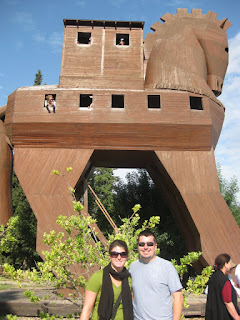
Tuesday we woke up and had breakfast in Cannakale before taking a short trip to the ancient ruins of Troy. Troy is of course famous for the tale of the Trojan horse, in which the Greeks take Troy by hiding in a large wooden horse and then emerging to attack once the horse had been brought inside the supposedly impermeable fortress walls by the curious Trojans. Exactly how the Greeks were able to conquer Troy is unknown, but the incredibly tacky yet fun replica wooden horse tourists can climb inside aside, Troy is a fascinating ancient site.
While unique, Troy is not one of the better preserved of the 2000 ancient city ruins in Turkey. There are many reasons for this, earthquakes, the Greek/Troy war, bugs/botanicals, and most interestingly, German Schliemann, who began excavations in the 19th century was interested in one thing, and it wasn’t preserving the city, it was treasure. Schliemann signed an agreement with the Ottomans before beginning excavations that any treasure he found would be split 50/50 with the Sultan. However, when he finally found the treasure he cleverly gave his workers the day off stating it was his wife’s birthday and wrapped off the treasure and left. The treasure was taken to Russia, but Schliemann had written an agreement with them that one day the treasure would go to his homeland, Germany. Unfortunately in the process of finding his treasure, Schliemann damaged man of the ruins.
Troy was a wealthy city in its day, which may explain why it thrived for so many centuries. Troy was wealthy because of its location. From the top of Troy one can see the Dardanelles, the South of the peninsula, and the Aegean Sea. The Aegean Sea, although now quite far from the ruins of Troy was once right at its door, and in these ancient times Troy collected taxes from boats waiting to pass through the Dardanelles. Throughout history civilizations would have to leave Troy for various reasons, such as war, and others would come along and find the existing structures and decide to build upon it, which is why in the ruins at Troy you can find various structures dating from 9 different centuries.
From Troy we had a couple hours on the bus before we arrived at Pergamum. Pergamum civilization dates back to 3000 B.C., but early civilization was not on the hilltop where the ruins still stand, but in the valley closer to where the ocean used to lie. One of Pergamum’s most famous ruins is the Great Alter which was dedicated to Zeus and Athena by Eumenes II in the 2nd century B.C. The Great Alter was built on the edge of the upper city so that all those inhabiting the lower city could see it as well. Unfortunately the Great Alter ruins can no longer be seen in Pergamum as they were taken by the Germans and reconstructed and the Great Alter is now on display in the Berlin Museum. Pergamum is also unique for a few other reasons. First, Pergamum was home to the first hospital in Roman times. Secondly, Pergamum produced the first parchment paper for the Roman Empire. Thirdly, Pergamum had the 2nd biggest library. Finally, this ancient city is home to the steepest amphitheatre of the ancient cities. Pergamum’s amphitheatre dates back to the 3rd century B.C. and could accommodate some 10,000 people.
After leaving Pergamum we had another couple of hours on the bus before we arrived in Kusadasi for our final overnight stay in Turkey.

No comments:
Post a Comment